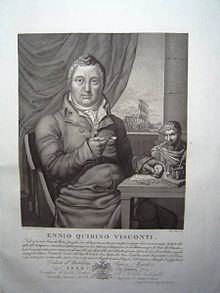Name Ennio Visconti | Children Louis Visconti | |
 | ||
Parents Giovanni Battista Visconti | ||
Ennio Quirino Visconti (November 1, 1751 – February 7, 1818) was an Italian antiquarian and art historian, papal Prefect of Antiquities, and the leading expert of his day in the field of ancient Roman sculpture. His son, Pietro Ercole Visconti, edited Versi di Ennio Quirino Visconti, raccolti per cura di Pietro Visconti while Louis Visconti became a noted architect in France. His brother, Filippo Aurelio Visconti (died 1830) was also a classical scholar, who published the Museo Chiaramonti, a successor to the Museo Pio-Clementino.
Contents
Biography
Born in Rome, he was the son of Giovanni Battista Antonio Visconti (1722–1784), the curator of Clement XIV, who reorganised and restored the papal collection of antiquities, as the Museo Pio-Clementina. Appointed by Pope Pius VI to succeed his father in the position, the brilliant and precocious Visconti took up his father's position as conservator of the Capitoline Museums in Rome in 1787; he assisted his father in producing the first volume of the Museo Pio-Clementino (1782) and produced the six remaining volumes himself, completing the last in 1807; this catalogue of the Roman sculpture and antiquities in the Vatican collections, published in the course of many years, "made an impact on archaeological studies second only to that of Winckelmann." He also published the antiquities collected in Greece by Sir Richard Worsley in Museum Worsleyanum (1794) and the sculptures in the Villa Borghese, (1796).
In 1798, he became one of five consuls of the short-lived Roman Republic. With the restoration of papal control in Rome he had to emigrate to Paris, where his presence was most welcome: "this event we considered as one of the happiest results of our victories", wrote the antiquary Aubin-Louis Millin de Grandmaison. At the end of 1799 he became curator of antiquities of the Musée Napoleon housed in the Louvre, many of which were familiar to him as booty removed under the stipulations of the Treaty of Tolentino (1796); his descriptions were published by Robillard-Perronville in Le Musée français; In 1803 he was made professor of archaeology at the Institut de France. In Paris he published a series of portraits of famous men of Antiquity: Iconographie Grecque, 3 vols. 1808, and a first volume of Iconographie Romaine, 1818. At his death, extended obituaries were published by Quatremère de Quincy and others.
When Parliamentary debates were mooting the acquisition of the Elgin Marbles for the British nation, Visconti was among the scholars asked to offer statements of their cultural value; his memoir was translated into English and published.
Visconti was succeeded as curator of antiquities at the Louvre by the comte de Clarac. Though he was firmly grounded in the antiquarian traditions of connoisseurship, which rated associative values high, in portraits and assumed portraits of the great—both philosopohers and emperors— and though he concentrated on disentangling the iconography of the sculptures and reliefs he was describing, Visconti is also a liminal figure at the beginnings of modern art history, as when, Haskell and Penny note, he concedes that he has perhaps overestimated the beauty of a statue in his delight at recognising in it the portrait of Phocion. His sense of loyalty to the sculpture he had grown up with induced him to see in the best of these copies of classical Greek and Hellenistic originals, such as the Apollo Belvedere and the Laocoön, "perfected imitations" made for Roman collectors of taste, and that the traditions of ancient sculpture were a cumulative history of improvements, rather as Virgil, it was felt, refined and improved upon Homer.
Works
These five works were reissued, with emendations, in Milan, 1827–37, some under the title Opere varie italiane e francesi edited by Giovanni Labus.
